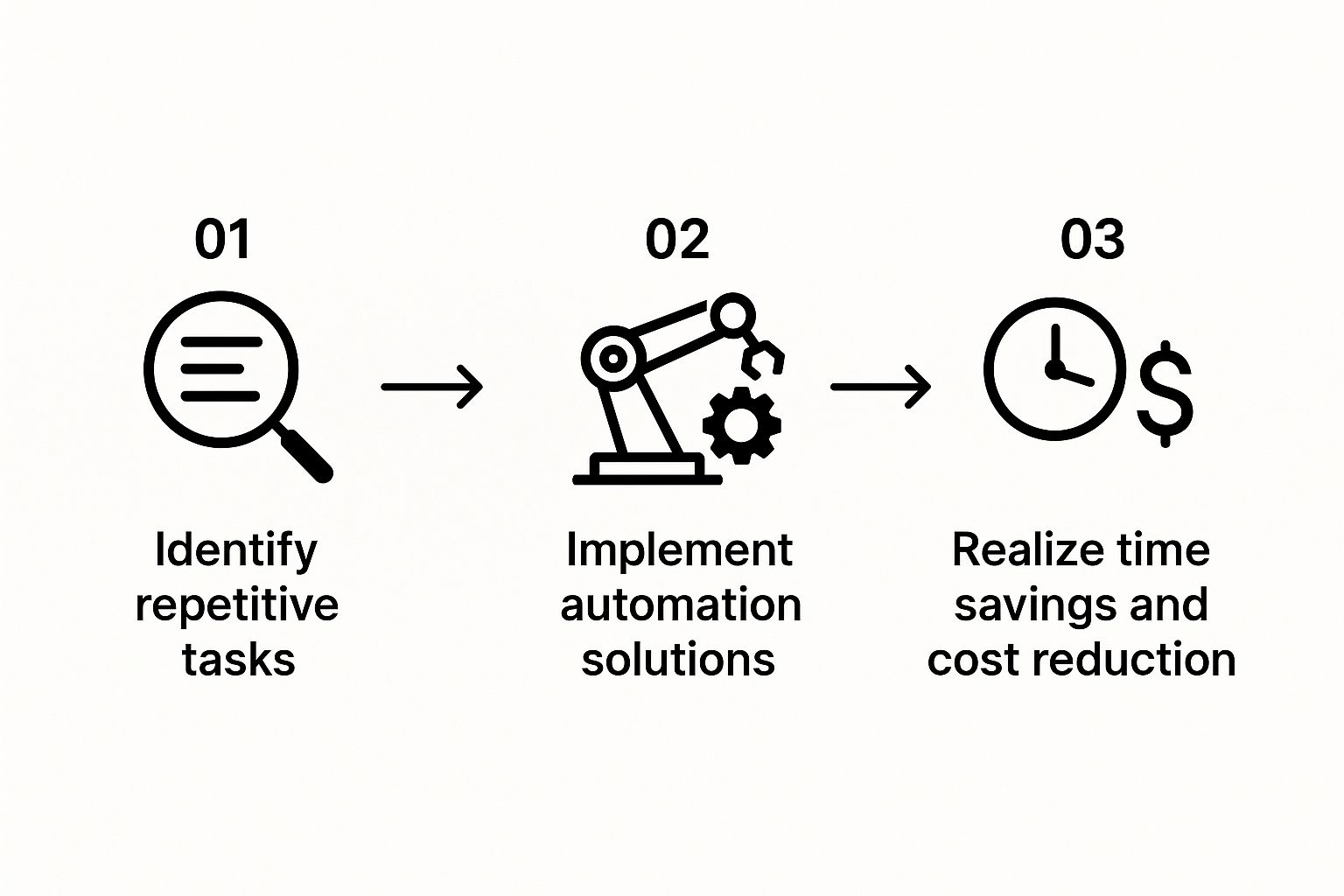How to Automate Business Processes: A Practical Guide
Learning how to automate your business operations isn't about some complex, secret formula. At its core, it’s about a straightforward, practical approach: first, you find the repetitive, rule-driven tasks that drain your team's time. Then, you pick the right technology to handle that work. Finally, you keep an eye on these new automated workflows to refine and improve them over time.
The goal is simple: let software take over the monotonous stuff so your people can focus on the work that actually grows the business.
Why Automating Business Processes Is a Must for Growth
Let's cut through the hype. Business process automation isn't just a trendy concept anymore—it's a critical strategy for any company that wants to stay in the game. It’s all about using technology to run recurring tasks and workflows that humans used to do. But the real story here is how today's tools are completely changing the game, making old-school manual work a serious handicap.
The pressure to deliver more with less isn't going away. When you’re still relying on manual methods for things like data entry, processing new customer accounts, or pulling weekly reports, you’re creating bottlenecks that literally hold your business back. These slow-downs don't just eat up time; they're a breeding ground for human error, lead to frustrated employees stuck with boring work, and cripple your ability to react quickly to what's happening in your market.
The Real-World Impact of Automation
Picture a medium-sized e-commerce business trying to keep up with order fulfillment. The team is manually punching order information into the shipping system, updating inventory in a spreadsheet, and then typing out tracking emails. Every single step is a chance for something to go wrong.
A simple typo in an address means a lost package and an angry customer. Forgetting to update the inventory sheet leads to selling products you don't have, which is a quick way to tarnish your reputation.
Now, let's see how that same company looks after implementing automation. When a new order comes in:
- An automation bot immediately grabs the order information.
- It pushes the data into the shipping software and prints a label.
- At the same time, it updates the inventory count across all systems in real-time.
- To finish, it sends a branded confirmation email to the customer, complete with the tracking link.
This whole sequence is over in seconds, with zero human input. That shift frees the team from mind-numbing copy-and-paste jobs. Now, they can spend their time on things that actually matter, like analyzing sales data to find trends, figuring out how to improve the customer experience, or launching new marketing campaigns.
By taking over rule-based, repetitive activities, automation directly converts saved hours into opportunities for innovation and growth. It’s not about replacing people, but rather elevating their roles from task-doers to strategic thinkers.
A well-planned automation strategy delivers a host of advantages. Here’s a quick look at the core benefits you can expect.
Core Benefits of Business Process Automation
| Benefit Area | Description | Example Impact |
|---|---|---|
| Increased Productivity | Software bots work 24/7 without breaks, handling tasks much faster than humans. | An HR department automates employee onboarding, cutting the time to provision new accounts from 3 days to 15 minutes. |
| Reduced Costs | Automating tasks lowers operational expenses by reducing the hours needed for manual labor. | A finance team saves $50,000 annually by automating invoice processing and accounts payable tasks. |
| Improved Accuracy | Automation eliminates human error in data entry and repetitive processes, ensuring consistency. | An e-commerce company reduces shipping errors by 99% by automating address validation and label creation. |
| Enhanced Compliance | Automated workflows ensure every step in a process is followed and documented, simplifying audits. | A bank maintains a perfect audit trail for loan applications by automating the required compliance checks. |
| Better Employee Morale | Freeing staff from tedious, low-value work allows them to focus on more engaging and strategic initiatives. | After automating report generation, a marketing team's satisfaction score increases by 25%. |
These benefits aren't just theoretical; they represent tangible improvements that drive a business forward.
The Compelling Case for Automation Technology
The rapid adoption of technologies like Robotic Process Automation (RPA) really drives this point home. An incredible 78% of companies are already using or actively planning to use RPA. This huge momentum is fueled by a powerful return on investment (ROI), which often falls between 30% and 200% in the very first year.
These aren't just flashy numbers; they show that automation is a proven path to cutting costs while seriously boosting productivity. You can explore more data on RPA effectiveness to see exactly how businesses are getting these kinds of results.
Ultimately, learning how to automate your business processes is about building a company that's more resilient, efficient, and ready to scale. It’s the key to unlocking what your team is truly capable of and creating a solid foundation for long-term growth.
Identifying and Prioritizing Processes for Automation
Jumping into automation without a clear target is like sailing without a compass—you’ll be busy, but you won’t get anywhere meaningful. The first, and arguably most critical, step is figuring out what to automate. This goes way beyond just looking for "repetitive tasks." It’s about strategically finding the opportunities that will deliver the biggest wins right out of the gate.
The best way to start? Talk to the people who actually do the work every day. Your team members are on the front lines and have an intimate understanding of where the real operational snags and time-sucking activities are. Running a process discovery workshop is a fantastic way to unearth these hidden pain points.
Uncovering Automation Opportunities
Get key players from different departments in a room and ask them some simple but powerful questions. Your goal is to pinpoint tasks that are not only repetitive but also have a significant downstream impact on the business.
Here are a few questions I always start with to guide the conversation:
- Time Consumption: Which daily or weekly tasks eat up the most hours but require the least amount of critical thinking?
- Error Prone: Where do mistakes happen most often? Think about data entry, manual calculations, or copy-pasting information between systems.
- Bottlenecks: What processes consistently slow down projects or delay customer service?
- Employee Frustration: What tasks does your team absolutely dread doing? Automating these can be a quick morale booster.
The answers will give you a raw list of potential automation candidates. The next step is to analyze and rank them systematically. To get your team's creative juices flowing, it can be helpful to review some powerful business process automation examples from other industries. This often sparks ideas they might not have considered.
Creating a Process Prioritization Matrix
Once you have a list of potential processes, you need an objective way to prioritize them. A simple scoring model or a prioritization matrix is your best friend here. It stops you from chasing low-impact projects and helps you evaluate each candidate against a consistent set of criteria that align with your business goals.
For instance, a finance department might be weighing the automation of its accounts payable process against its monthly budget reporting. Both are time-consuming, but which one offers a better return on investment for an initial automation project?
The goal isn't just to automate for the sake of it, but to make strategic choices that build momentum. A successful first project creates buy-in and proves the value of your automation strategy to the entire organization.
The following graphic really brings home the fundamental flow, from identifying tasks to seeing the benefits.

This visual shows the direct line from pinpointing repetitive work to achieving tangible outcomes like saved time and reduced costs.
To build your own matrix, score each potential process on a scale of 1 to 5 across several key dimensions. Here’s a practical example you can adapt for your own workshop:
| Prioritization Criteria | Description | Scoring (1-5) |
|---|---|---|
| Frequency | How often does this process occur? (1 = Yearly, 5 = Hourly) | |
| Time Saved | How many employee hours per week would be saved? (1 = <1 hour, 5 = >10 hours) | |
| Business Impact | How critical is this process to revenue or customer satisfaction? (1 = Low, 5 = High) | |
| Error Rate | How often do human errors occur in this process? (1 = Rarely, 5 = Frequently) | |
| Implementation Ease | How difficult is it to automate this process? (1 = Very Hard, 5 = Very Easy) |
Tallying the scores for each potential process gives you a clear, data-informed ranking. The tasks with the highest scores are your prime candidates for automation—they represent the sweet spot of high frequency, significant time savings, and critical business impact.
For a deeper dive into creating a comprehensive plan, check out our guide on building https://makeautomation.co/your-roadmap-to-implementing-business-process-automation/. This strategic approach ensures your first steps into automation are confident, impactful, and set the stage for future success.
Mapping Your Workflows Before You Automate

Jumping into automation without first mapping out the process is like trying to build a house without a blueprint. It’s a recipe for wasted time, blown budgets, and a whole lot of frustration. You're basically asking a bot to follow directions to a place you can’t even describe.
This mapping stage is non-negotiable. It’s where you take a vague idea for improvement and turn it into a concrete, actionable plan.
The beauty of mapping is that it does more than just prepare you for automation. It forces you to put every single step under a microscope, which almost always uncovers hidden bottlenecks and inefficiencies you didn't know existed. You might discover that a process you thought was straightforward is actually a tangled mess of workarounds and exceptions.
Inefficient workflows aren’t just a minor headache; they're a serious drain on morale and productivity. More than 50% of employees say clunky processes are a major cause of poor work-life balance. By smoothing out these operations, automation can slash errors by up to 70%. And it doesn't just benefit your team—companies that get this right see an average 6.7% bump in customer engagement. You can find more detail behind these numbers in these process automation statistics on ziphq.com.
Documenting a Process from Start to Finish
So, where do you begin? Let's take a common, high-impact example: customer onboarding. This process is usually a jumble of manual handoffs between sales, customer success, and technical teams, making it a perfect candidate for mapping.
Your first job is to trace every single action, from the moment a deal closes to when the customer is fully up and running. This isn't a task for one person in a dark room. You need to get everyone involved who touches the process. Each person holds a piece of the puzzle, and their view of how the work actually gets done is often very different from the "official" procedure.
Get the team together with a whiteboard, a stack of sticky notes, or a digital canvas and start laying it all out.
- The Trigger: What kicks the whole thing off? A "deal won" status change in your CRM is a classic example.
- The Tasks: List every action, no matter how small. Think: "Create customer account in billing software," "send welcome email sequence," "schedule kickoff call."
- The Decision Points: Where does the path fork? For instance, does the onboarding flow change for an enterprise client versus a standard one?
- The Handoffs: Pinpoint where responsibility shifts. This is often where things fall through the cracks, like when Sales passes the baton to a Customer Success Manager.
- The Exceptions: What happens when things go off-script? A failed payment, an unopened welcome email—these are the real-world scenarios your automation must be built to handle.
Don’t gloss over the exceptions. This is one of the most common—and costly—mistakes I see. Planning for the "happy path" is easy, but robust automation is defined by how it handles the inevitable bumps in the road.
Choosing the Right Mapping Technique
You don’t need a fancy certification to draw a useful map. The goal is to choose a method that fits the complexity of what you’re trying to fix.
For most business processes, a simple flowchart is your best friend. It uses basic, universally understood shapes—ovals for start/end points, rectangles for tasks, and diamonds for decisions. It’s clean, easy to create, and perfect for getting everyone on the same page.
If you’re tackling something incredibly complex with dozens of systems and intricate business rules, you might look into Business Process Model and Notation (BPMN). It’s a far more rigorous and standardized method, but it comes with a steep learning curve and often requires specialized tools. Honestly, for most automation projects, it's overkill. Start simple.
Your process map is your single source of truth. It ensures the automation you build is what your business actually needs, preventing costly rework and misalignment down the line.
Once you have this visual guide, opportunities will jump out at you. You might notice, for example, that your team is manually typing the exact same customer information into three different systems. That’s a glaringly obvious win for automation. If that sounds familiar, you can get specific ideas on how to solve it by exploring how to automate data entry tasks.
By dedicating real time and effort to mapping, you’re not just preparing to automate a task. You’re fundamentally improving the way your business runs.
Choosing the Right Automation Tools and Technologies

Okay, you've identified and mapped your processes. Now comes the part where many initiatives either gain momentum or stall out completely: picking the right technology.
The market is flooded with automation tools, and it's easy to get overwhelmed. I’ve seen companies make two common mistakes here. They either pick a tool that’s too basic and quickly outgrow it, or they buy something so complex and expensive that it never gets fully adopted. Both paths lead to wasted time and money.
The secret is to stop looking for one magic tool that does everything. Instead, think about building a specialized toolkit. Different tools are built for different jobs, budgets, and technical comfort levels.
The Main Categories of Automation Tech
The technology you land on should be a direct answer to the needs you uncovered during your process mapping. A simple, repetitive task requires a very different solution than a complex workflow that touches multiple teams and systems.
Let's break down the main players in the automation space:
-
Integration Platforms (iPaaS): Think of tools like Zapier or Make. These are the digital duct tape that connects your various cloud applications. They excel at creating simple "if this, then that" automations between the services you already use.
-
Robotic Process Automation (RPA): Platforms such as UiPath or Automation Anywhere use software ‘bots’ to mimic how a human interacts with a computer. RPA is your go-to for automating tedious, rules-based tasks in older systems or applications that lack modern APIs for connection.
-
Business Process Management (BPM) Suites: BPM software is the heavy lifter. It's built to manage and orchestrate complicated, long-running processes that span the entire organization, giving you a bird's-eye view and deep control.
-
No-Code/Low-Code Platforms: These are game-changers for empowering your teams. They provide visual, drag-and-drop interfaces that let non-technical staff build and automate their own custom applications and workflows, taking the pressure off your IT department.
This move from automating single tasks to building intelligent, interconnected systems is what the industry calls hyperautomation. It's not just a buzzword; it's a fundamental change in how modern businesses operate. The U.S. hyperautomation market, currently valued at over $14 billion, is projected to rocket to almost $70 billion within the next decade.
Automation Technology Comparison
So, how do you decide? It's a balancing act. You have to weigh the complexity of your process against your team's technical skills and, of course, your budget. A small business running a few automations doesn't need a full-blown enterprise BPM suite. Likewise, a large corporation will find a simple integration tool too limiting for its core operations.
To help you find the right fit, here’s a quick breakdown of how these technologies stack up against each other.
| Technology Type | Best For | Example Use Case | Technical Skill Level |
|---|---|---|---|
| Integration Platforms | Connecting cloud apps and automating simple, linear tasks. | Automatically posting new blog articles to all social media channels. | Low (No-code) |
| RPA | Automating repetitive, manual data entry on desktop applications. | Copying data from an old spreadsheet into a new CRM system daily. | Medium to High |
| BPM Suites | Managing and optimizing complex, multi-stage business processes. | Orchestrating a complete customer onboarding and provisioning workflow. | High (Requires IT) |
| No-Code/Low-Code | Empowering business teams to build their own internal apps. | Creating a custom project approval app for the marketing team. | Low to Medium |
A Note from Experience: The best automation strategies I’ve seen almost always use a mix of these technologies. You might use an iPaaS tool for marketing, an RPA bot for finance, and a no-code platform for internal HR apps. This creates a flexible and powerful tech stack.
Remember, AI often acts as a layer of intelligence on top of these platforms. It's what turns a simple automation into a smart one. For a real-world example, look at how automated candidate screening applies AI to a high-volume HR process, saving countless hours.
By carefully matching the tool to the task, you’re not just buying software. You’re making a strategic investment in a solution that will grow with you.
Monitoring Performance and Scaling Your Wins
Getting your first automated workflow live is a great feeling. But that’s just the starting line, not the finish. The real magic happens in what you do next. Without a solid plan for monitoring and scaling, even the most brilliant automation will eventually fizzle out or become obsolete.
This is the point where you need to shift your thinking. You’re not just managing a one-off project; you're cultivating a new, more efficient way of working across the business. It’s a continuous loop: measure, learn, and expand. This is how you turn a single success into a company-wide advantage.
Keeping Score: How to Know if You’re Winning
You can't fix what you can't see. Before you even launch your new automated process, you have to be crystal clear on what success looks like. These key performance indicators (KPIs) are your North Star, telling you if the automation is actually doing its job and showing you where to tweak things.
Think back to the original problems you set out to solve. If you wanted to reclaim precious time, your main metric is process cycle time. If you were trying to eliminate costly mistakes, you’ll be watching the error reduction rate like a hawk.
Here are a few essential metrics I always recommend tracking from day one:
- Process Cycle Time: How long does the whole process take now, from start to finish? Pit this number directly against your old manual benchmark. The difference is your speed gain.
- Error Rate: What percentage of tasks now run without a single human touch or correction? Your goal should be to get this as close to zero as humanly (or robotically) possible.
- Cost Savings: Tally up the real financial impact. This isn't just about saved labor hours; it includes less wasted material, fewer penalties, and the reduced cost of fixing mistakes.
- Automation Uptime: Is your bot or workflow ready when you need it? This metric shows the percentage of time your automation is operational, which is absolutely critical for processes the business relies on.
- Team Morale: Don’t skip the human side of the equation. Check in with the team whose jobs you just changed. A quick survey can tell you if they're feeling more engaged now that the soul-crushing repetitive work is off their plate.
Don't let these numbers get buried in a spreadsheet. A simple dashboard, maybe in a tool like Looker Studio or even within your automation platform’s own analytics, can bring these metrics to life. This visual proof makes the value undeniable to everyone—from the team on the ground to the C-suite—and helps build momentum for what's next.
From One Win to a Pipeline of Success
That first successful automation is your MVP. It's the proof that this works. Now, you can use that momentum to build something bigger and more sustainable. The aim is to create a self-funding engine where the savings from one project help pay for the next one. It’s a powerful compounding effect.
This is where a more formal approach, often called an automation Center of Excellence (CoE), really shines. It sounds a bit corporate, I know, but even for a small team, it's just a structured way to manage the journey. Think of it as a central hub responsible for finding new opportunities, setting best practices, and sharing what works across the entire company.
Your CoE is the brain of your automation strategy. It ensures you're not just launching random, disconnected bots, but are actually building a smart, cohesive system that drives tangible business results.
The CoE’s job is to manage a pipeline of potential automation projects, using the same kind of prioritization matrix you used for your first one. When ideas bubble up from different departments, they get evaluated, scored, and placed on the roadmap. This disciplined process makes sure you're always tackling the projects that will deliver the biggest bang for your buck.
Knowing what to expect is key, and our guide on the top 10 business process automation benefits can help you build a stronger business case for your pipeline.
By creating a clear system for watching your live automations and strategically planning new ones, you foster a culture of constant improvement. You’re no longer just putting out fires; you're fundamentally building a smarter, stronger, and more scalable organization.
Answering Your Automation Questions

Even with a solid plan, you're bound to have questions. Stepping into the world of automation is a big move, and it's perfectly normal to have some uncertainty. Let's dig into some of the most common questions I hear from leaders and provide some real-world advice you can use.
Think of this as your practical, no-fluff Q&A to clear up any lingering confusion and help you move forward with confidence.
How Do I Get Buy-In From Everyone?
This is a big one. Getting your whole team on board with automation isn’t a one-size-fits-all pitch. You actually need two different game plans: one for your leadership and another for your employees on the ground. They have very different concerns, so your approach has to speak to each group directly.
For management, it’s all about the numbers. Build a rock-solid business case using the data you gathered earlier. Show them the projected ROI, the hard cost savings from cutting down manual work, and how much faster and more accurate your operations will be. It's about demonstrating a clear competitive edge.
The conversation with your employees is totally different. Let’s be honest—their first thought is often about job security. You have to tackle that fear head-on. Frame automation as a tool that frees them from the mind-numbing, repetitive parts of their jobs so they can focus on more important work. The best way to do this? Involve them from the start. Ask them what tasks drain their energy the most, and make those your first automation targets.
A small, successful pilot project is your best friend. When you automate one frustrating process and people see their coworkers' daily grind get genuinely easier, you create instant advocates. Their stories will do more to convince the skeptics than any slide deck ever could.
This shifts the dynamic from a top-down order to a team effort to make everyone's work better.
What Is the Difference Between Automation and Hyperautomation?
People sometimes throw these terms around as if they mean the same thing, but they represent two vastly different concepts. Knowing the difference is crucial for setting a smart long-term strategy.
Standard automation is about tackling specific, rule-based tasks. It's like teaching a software bot a very precise script that it follows every single time. A classic example is using Robotic Process Automation (RPA) to scrape data from an email and plug it into your CRM. It’s targeted, effective, and solves a clear, repetitive headache.
Hyperautomation, on the other hand, is a much bigger, more strategic play. It’s not just about automating one task; it’s about looking at an entire business process from end to end and intelligently optimizing the whole thing. It brings together a whole suite of technologies to make this happen:
- Artificial Intelligence (AI)
- Machine Learning (ML)
- Process Mining tools
- Robotic Process Automation (RPA)
This tech stack creates an intelligent system that can find, analyze, and constantly refine how work gets done. It can handle messy, unstructured data, make informed decisions, and learn from its own performance. It’s the difference between automating invoice data entry and building a system that can intelligently manage your entire accounts payable workflow, from receiving the invoice to strategically timing payments for maximum benefit.
What Are the Most Common Mistakes to Avoid?
Sometimes, knowing what not to do is just as valuable as knowing what to do. From my experience, most automation projects don't fail because the tech is bad. They fail because of a few common, and totally avoidable, missteps.
Here are the big ones I see time and time again:
- Automating a broken process. This is the number one killer. If your current manual process is a mess, all automation will do is help you get bad results faster. You have to map, streamline, and fix the process before you let a bot anywhere near it.
- Choosing the wrong tool. This happens when a business hasn't clearly defined its needs. They either buy a cheap tool that can't handle the job's complexity or splurge on an enterprise platform that's overkill and a nightmare to implement. The tool has to fit the task.
- Forgetting the people. Failing to communicate what you're doing and why is a surefire way to create fear and resistance. If your team sees automation as a threat, the project is doomed. You have to bring them along for the ride.
- Failing to plan for scale. Many businesses treat automation as a one-off project. They fix one small thing and stop. This misses out on the incredible compounding benefits you get from building an ongoing automation program across the entire organization.
Navigating the world of automation can be complex, but you don't have to do it alone. MakeAutomation specializes in creating and implementing the exact automation frameworks that B2B and SaaS businesses need to scale effectively. We help you get past the manual grind to build efficient, AI-powered operations that drive ROI and free up your team for the work that matters most.
Ready to build a more scalable business? Learn how we can help at https://makeautomation.co.







